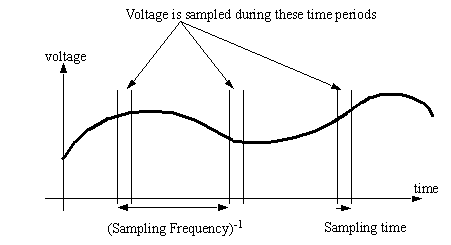1.2 ANALOG SIGNALS
• A Continuous signal is sampled by the computer
• The computer uses approximation techniques to estimate the analog value during the sampling window.
• An example of an A/D, D/A control of a process is shown below
• Multiplexers are used when a number of signals are to be input to a single A/D converter. This allows each of a number of channels to be sampled, one at a time
• Signal conditioners are often to amplify, or filter signals coming from transducers, before they are read by the A/D converter.
• Output drivers and amplifiers are often required to drive output devices when using D/A
• Sampling problems occur with A/D conversion. Because readings are taken periodically (not continually), the Nyquist criterion specifies that sampling frequencies should be twice the frequency of the signal being measured, otherwise aliasing will occur.
• Since the sampling window for a signal is short, noise will have added effect on the signal read. For example, a momentary voltage spike might result in a higher than normal reading.
• When an analog value is converted to or from digital values, a quantization error is involved. The digital numbering scheme means that for an 8 bit A/D converter, there is a resolution of 256 values between maximum and minimum. This means that there is a round off error of approximately 0.4%.

1.2.1 Analog to Digital Conversion
• When there are analog values outside a computer, and we plan to read these to digital values, there are a variety of factors to consider,
- when the sample is requested, a short period of time passes before the final sample value is obtained.
- the sample value is ‘frozen’ after a sample interval.
- after the sample is taken, the system may change
- sample values can be very sensitive to noise
- the continuous values of the signal loose some accuracy when conversion to a digital number
• Consider the conversion process pictured below,
• Once this signal is processes through a typical A/D converter we get the following relations (these may vary slightly for different types of A/D converters).
• In most applications a sample is taken at regular intervals, with a period of ‘T’ seconds.
• In practice the sample interval is kept as small as possible. (i.e., tau << T)
• If we are sampling a periodic signal that changes near or faster that the sampling rate, there is a chance that we will get a signal that appears chaotic, or seems to be a lower frequency. This phenomenon is known as aliasing.
• Quite often an A/D converter will multiplex between various inputs. As it switches the voltage will be sampled by a ‘sample and hold circuit’. This will then be converted to a digital value. The sample and hold circuits can be used before the multiplexer to collect data values at the same instant in time.
1.2.1.1 - Flash A/D Converter
• On type of A/D converter is the flash converter shown below,
• These converters are very fast, but they are hard to build for high resolutions.
• The conversion rates for these devices are limited by inherent capacitance, and transistor switching times.
1.2.2 Digital to Analog Conversion
• After we have used a controller equation to estimate a value to put into our process, we must convert this from a digital value in the computers memory, to a physical voltage.
• This voltage is typically limited to 20mA in most computer board, and drawing near this current reduces accuracy and life of the board.
• A simple circuit is shown below for a simple digital to analog converter.
• The calculations for the A/D converter resolution and accuracy still apply.
• Consider the example below,